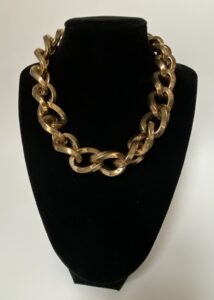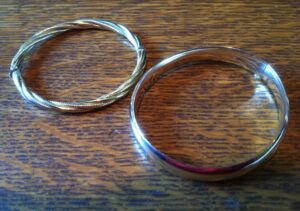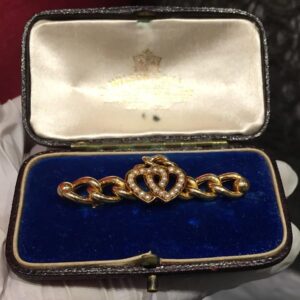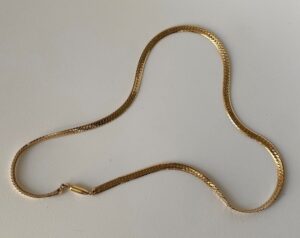
by Dr. Lori Verderame
Many people love the sparkle of fine jewelry and it is necessary to know what marks on a piece of jewelry demonstrate its value. Since bling comes in many shapes, forms, and sizes including necklaces, bracelets, earrings, rings, anklets, pendants, pins and brooches, you have to know what the tiny gold jewelry karat marks mean.
If you want to know how to tell value in gold jewelry, there are some things you have to know. To find valuable jewelry at the thrift store, yard sale, antiques shop, estate sale, or online, you have to know about troy ounces, karat weight, and purity marks.
Here are the most important marks and indicators that you need to know when it comes to identifying fine and valuable costume jewelry. The most important things to know when it comes to jewelry identification are the marks on jewelry pieces and there are many marks on jewelry. These gold jewelry karat marks on jewelry are all about weights and measurements, makers’ and designers’ marks, and purity and fineness. I also offer another gold jewelry list of marks in another article which highlights more differences.
What to Look For

Before you decide to buy that piece of jewelry, you have to consider many factors including its weight. The look will attract you but it is the weight and other factors that point to value. The weight of a gold piece of jewelry is measured in troy ounces. What is a troy ounce and how does that differ from a regular or standard ounce? A troy ounce is a commonly used term in the jewelry field.
Weights and Measures
What is a troy ounce? How does it affect me when I buy a piece of jewelry? To be exact, 1 troy ounce equals approximately 31 grams. A troy ounce is a unit of measurement that is commonly used to measure precious metals. The troy ounce measurement dates back to the Middle Ages, circa 800 AD – 1200 AD. The troy ounce measurement was first used in Troyes, France. Now, do you get it? Troy ounce from Troyes, France!
Troy Ounce Marks
Looking back in history, as people traded items internationally, there was a need for a standardized weight system for items bought and sold in the marketplace. Troy weights were used in France and later, circa 1527, in Great Britain as the official standard measurement for weighing precious metals. In 1828, the United States started to use troy ounces to weigh its precious metals. The Americans decided to jump on the troy ounce bandwagon much later than the rest of the world. There are 14.6 troy ounces to a pound versus 16 standard ounces to a pound. The mark of troy ounces is a mark that will be found on some pieces of jewelry, silverware, and other items.
The troy ounce is the last of the original metrics still used to weigh precious metals –and particularly jewelry pieces–such as platinum, silver, and gold. A standard ounce, which differs from a troy ounce, is often used for measuring foodstuffs and it is equal to approximately 28 grams. Many items will have troy ounces marked on the piece in the form of a stamp, embossed mark, or hallmark.
Karats and Purity Marks

Now that we know about the troy ounce measurement, let’s look at karat weight. Not to be confused with carats, the karat we are going to discuss is all about gold and other precious metals. Karat weight is also known as or called karatage and it is used in jewelry manufacturing and collecting. Karat weight or karatage is very important as a jewelry purity or fineness measurement. The purity or fineness amount in gold, silver, platinum and other precious metals is measured in karats. Karat weight or karatage shows the measurement of purity of gold, silver, platinum, and other precious metals.
Here’s how it works for gold jewelry karat marks. A piece of gold jewelry that is 24 karat gold is considered pure gold. That means that there are no other metals and no other alloys mixed with the gold—it is quite simply pure gold. Pure gold has a 24 karat weight. If it had other metals or alloys mixed in with it, then the gold would have a different karat weight. Some of the most common karat weights are less than 24 karats. So if you can find 24 karat gold that is pure gold. Other gold karat weights which should be familiar are 18 karat gold. 18 karat gold measures 75% pure gold. There is also 14 karat gold. 14 karat gold measures 58.5% pure gold. These two other karat weights—18 karat and 14 karat–are the most common karat weights used in fine jewelry pieces like necklaces, rings, earrings, bracelets, brooches, pins, anklets, pendants, etc. They are mixed with other metals, of course, but are considered fine jewelry too.
International Gold Marks
On the world stage, these measurements, weights, and karat weights come into play too. Various countries use related measurements. So, to simplify all this talk about gold, here is some basic information about gold jewelry karat marks.
In order to call a piece “gold” in a certain country then that piece of jewelry must have a particular amount of gold fineness or gold purity. That particular amount of gold fineness or gold purity is different in other countries around the world. So, while a piece of jewelry must meet a fineness or purity standard, it must also achieve a certain karat weight too. Jewelry pieces that are considered gold differ by country because the definition of gold by karat weight differs by country. For instance, in Denmark and Greece, a piece of jewelry is considered gold if it has a minimum of 8 karats. That is not the case in other countries. For example, Austrian, British, French, Irish, and Portuguese jewelry is considered gold if it has a fineness amount of at least 9 karats weight. So that differs from the gold standard for Denmark and Greece and other places, too. And, in the United States of America, 10 karats is the minimum for a piece to be considered gold by purity standards. So, this means that you may be buying a piece of gold abroad and find that it has a lower gold karat weight than the same piece purchased at home. Be aware of the karat weight when shopping in other countries as this has an impact on the price, the retail value, and the quality of the piece of jewelry. Get as much information as you can before you buy.
No more 15 karat gold?
It is very important if you are a collector or reseller of jewelry that you know the many different international gold purity marks. They are very important and these marks will come up when buying or selling pieces of jewelry. For instance, some pieces of gold jewelry from Great Britain are marked 15 karat gold or marked 625. Why are they marked this way? In Great Britain, 15 karats or 625 are purity marks used in the jewelry business. The 15 karat gold mark or the 625 mark on a piece of gold jewelry means that the piece is 62.5% pure gold. This is a fineness or purity mark that has been used in Great Britain for quite sometime and it is not the same as 14 karat or 18 karat gold that is regularly used in the United States.
Appraising Queen Victoria’s Gold Pin

In the late Victorian period, that is in the late 1800s or 19th Century, the fineness mark of 15 karat gold jewelry was commonly traded in Great Britain and in other parts of the world. Back then, 15 karat gold pieces or those that had 62.5% gold were widely collected and held in high esteem with collectors.
Some pieces of 15 karat gold jewelry date to the Victorian period, the time period when Queen Victoria reigned, circa 1837-1901. These pieces are not marked the same way that American gold jewelry from that same time period is marked. Knowing the difference and recognizing the marks is necessary if you want to collect antique pieces. In the Victorian period, gold pieces from Great Britain were marked as 15 karat gold or marked with the numbers 625. In Great Britain, 15 karats and 625 are both purity marks on golds. The 15 karat gold mark or the 625 numerical mark on a piece of gold jewelry means that the piece is 62.5% pure gold. The 15 karat gold mark used in Great Britain is not the same mark that is used on 14 karat or 18 karat gold pieces in the United States.
In the late Victorian period or the late 1800s, the 15 karat gold jewelry fineness mark was commonly traded in Great Britain. It was used on this gold double heart pin with seed pearls that I appraised at my antiques appraisal event. The current owner acquired the beautiful Victorian gold pin from a relative who was a lady in waiting to Queen Victoria in the late 1800s. An amazing appraisal of 15 karat gold jewelry and it belonged to Queen Victoria and she gifted it to my client’s relative more than a century ago. Back then, 15 karat gold pieces were widely collected and held in high esteem; some were even part of the Queen’s personal collection.
Today, it is rare to find much 15 karat gold jewelry pieces traded on the market. While they do come to market online occasionally, they are not commonly bought and sold. Why? The answer is that 15 karat gold is a gold purity standard that was discontinued in 1932. So, if you find a piece of 15 karat gold jewelry then you automatically know it was marked and dates from the late 19th Century until 1932.
How did this all happened? The American gold standard of 14 karat gold bumped its British 15 karat gold counterpart out of the jewelry market. The main reason why 14 karat gold jewelry came to replace 15 karat gold jewelry is because 14 karat gold is slightly harder and somewhat more durable for everyday jewelry wear and use than 15 karat gold pieces. As a result, people were attracted to the American’s 14 karat gold jewelry pieces compared to the British 15 karat gold options.
Color is King
What other traits of gold jewelry impact its value besides gold jewelry karat marks? Color. A very important and obvious characteristic of 14 karat gold versus 15 karat gold is the color of the gold jewelry. Color is impacted by the karat weight difference when it comes to gold jewelry. A jewelry piece that is 14 karat gold is more pale gold in color than a piece of 15 karat gold jewelry. In some cases, 14 karat gold jewelry has a slight mossy green hue, too. While 15 karat gold jewelry has approximately 4% more pure gold than 14 karat gold jewelry does, 15 karat gold jewelry has a lovely yellow color that is recognizable to the trained eye and attractive to collectors on both sides of the pond and beyond.
Quick Facts

What is a troy ounce? 1 troy ounce equals approximately 31 grams.
A troy ounce is a unit of measurement that is commonly used to measure precious metals.
Troy ounces are marked on pieces of jewelry, silverware, and other items.
Karat weight or karatage is a jewelry purity or fineness measurement.
Pure gold does not have any other alloys mixed with it.
In fine jewelry, pure gold has a karat weight of 24 karats.
Some of the most common karat weights are less than 24 karats.
22 karat gold measures 91.7% pure gold.
18 karat gold measures 75% pure gold.
14 karat gold measures 58.5% pure gold.
10 karat gold measures 41.7% pure gold.
In Great Britain, France, and some other countries, the minimum gold purity standard is 9 karats.
In the United States of America, the minimum gold purity standard is 10 karats for a piece to be considered gold.
Watch videos on my YouTube channel as I show you more tips about gold jewelry karat marks. I can appraise your jewelry pieces from photos or you can show me your pieces during a video call.


